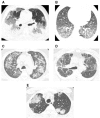Diagnosis and management of drug-associated interstitial lung disease
- PMID: 15340375
- PMCID: PMC2750814
- DOI: 10.1038/sj.bjc.6602064
Diagnosis and management of drug-associated interstitial lung disease
Abstract
Symptoms of drug-associated interstitial lung disease (ILD) are nonspecific and can be difficult to distinguish from a number of illnesses that commonly occur in patients with non-small-cell lung cancer (NSCLC) on therapy. Identification of drug involvement and differentiation from other illnesses is problematic, although radiological manifestations and clinical tests enable many of the alternative causes of symptoms in advanced NSCLC to be excluded. In lung cancer patients, high-resolution computed tomography (HRCT) is more sensitive than a chest radiograph in evaluating the severity and progression of parenchymal lung disease. Indeed, the use of HRCT imaging has led to the recognition of many distinct patterns of lung involvement and, along with clinical signs and symptoms, helps to predict both outcome and response to treatment. This manuscript outlines the radiology of drug-associated ILD and its differential diagnosis in NSCLC. An algorithm that uses clinical tests to exclude alternative diagnoses is also described.
Figures


Similar articles
-
The extent of ground-glass attenuation is a risk factor of chemotherapy-related exacerbation of interstitial lung disease in patients with non-small cell lung cancer.Cancer Chemother Pharmacol. 2018 Jan;81(1):131-139. doi: 10.1007/s00280-017-3476-5. Epub 2017 Nov 15. Cancer Chemother Pharmacol. 2018. PMID: 29143072
-
Nivolumab-induced interstitial lung disease analysis of two phase II studies patients with recurrent or advanced non-small-cell lung cancer.Lung Cancer. 2017 Feb;104:111-118. doi: 10.1016/j.lungcan.2016.12.016. Epub 2016 Dec 21. Lung Cancer. 2017. PMID: 28212992 Clinical Trial.
-
Evaluation of the safety and efficacy of combination chemotherapy with vinorelbine and platinum agents for patients with non-small cell lung cancer with interstitial lung disease.Anticancer Res. 2012 Dec;32(12):5475-80. Anticancer Res. 2012. PMID: 23225454
-
Interstitial lung disease associated with drug therapy.Br J Cancer. 2004 Aug;91 Suppl 2(Suppl 2):S18-23. doi: 10.1038/sj.bjc.6602063. Br J Cancer. 2004. PMID: 15340374 Free PMC article. Review.
-
Drug-induced interstitial lung disease in tyrosine kinase inhibitor therapy for non-small cell lung cancer: a review on current insight.Cancer Chemother Pharmacol. 2011 Nov;68(5):1099-109. doi: 10.1007/s00280-011-1737-2. Epub 2011 Sep 13. Cancer Chemother Pharmacol. 2011. PMID: 21913033 Review.
Cited by
-
Oxaliplatin-induced lung injury with allergic reaction.Chin J Cancer Res. 2011 Sep;23(3):232-5. doi: 10.1007/s11670-011-0232-y. Chin J Cancer Res. 2011. PMID: 23467619 Free PMC article.
-
Pharmacological Threat to Lungs: A Case Series and Literature Review.Cureus. 2017 May 9;9(5):e1232. doi: 10.7759/cureus.1232. Cureus. 2017. PMID: 28620563 Free PMC article. Review.
-
Bleomycin lung: a case report.BMJ Case Rep. 2009;2009:bcr11.2008.1175. doi: 10.1136/bcr.11.2008.1175. Epub 2009 Apr 14. BMJ Case Rep. 2009. PMID: 21686431 Free PMC article.
-
Molecular and Clinical Features of EGFR-TKI-Associated Lung Injury.Int J Mol Sci. 2021 Jan 14;22(2):792. doi: 10.3390/ijms22020792. Int J Mol Sci. 2021. PMID: 33466795 Free PMC article. Review.
-
Managing the Risk of Lung Toxicity with Trastuzumab Deruxtecan (T-DXd): A Canadian Perspective.Curr Oncol. 2023 Aug 30;30(9):8019-8038. doi: 10.3390/curroncol30090582. Curr Oncol. 2023. PMID: 37754497 Free PMC article. Review.
References
-
- Abid SH, Malhotra V, Perry MC (2001) Radiation-induced and chemotherapy-induced pulmonary injury. Curr Opin Oncol 13: 242–248 - PubMed
-
- American Thoracic Society (2002) American Thoracic Society/European Respiratory Society International Multidisciplinary Consensus Classification of the Idiopathic Interstitial Pneumonias. This joint statement of the American Thoracic Society (ATS), and the European Respiratory Society (ERS) was adopted by the ATS Board of Directors, June 2001 and by The ERS Executive Committee, June 2001. Am J Respir Crit Care Med 165: 277–304 - PubMed
-
- Aviram G, Yu E, Tai P, Lefcoe MS (2001) Computed tomography to assess pulmonary injury associated with concurrent chemo-radiotherapy for inoperable non-small cell lung cancer. Can Assoc Radiol J 52: 385–391 - PubMed
-
- Barlesi F, Villani P, Doddoli C, Gimenez C, Kleisbauer JP (2004) Gemcitabine-induced severe pulmonary toxicity. Fundam Clin Pharmacol 18: 85–91 - PubMed
-
- Baughman RP, Lower EE, Lynch JP (1994) Treatment modalities for sarcoidosis. Clin Pulm Med 1: 223–231
Publication types
MeSH terms
LinkOut - more resources
Full Text Sources
Medical

